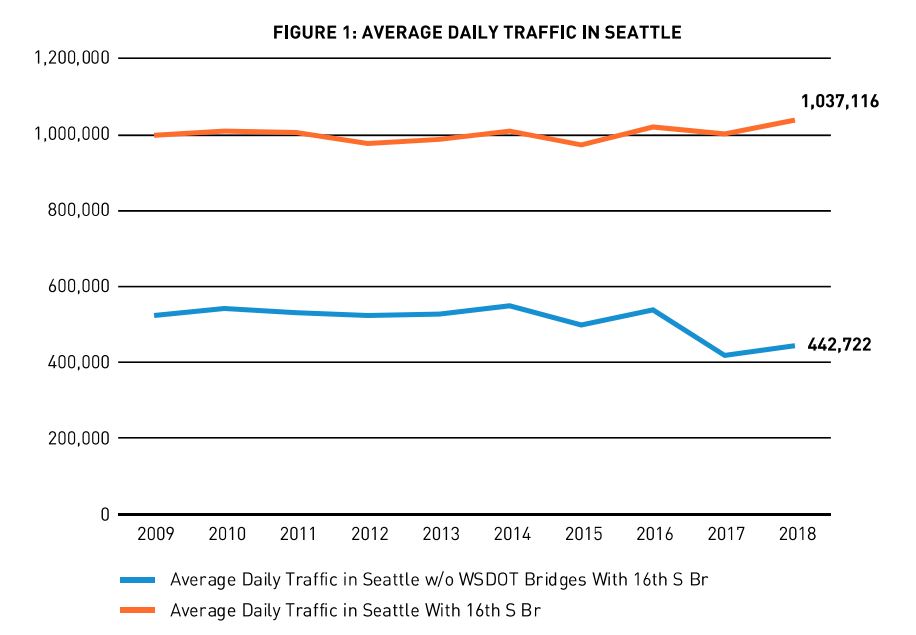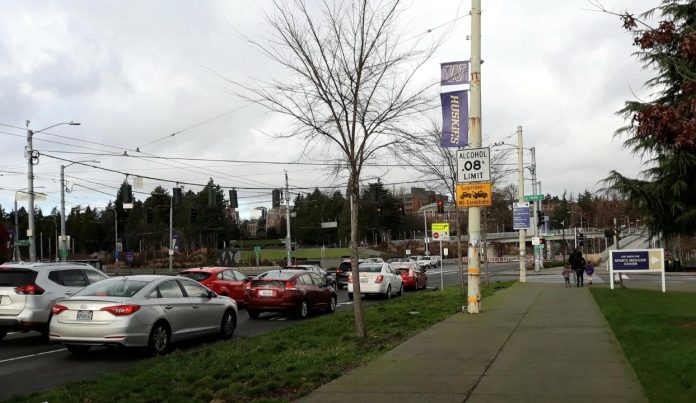Seattle’s average daily vehicle volumes increased by the largest amount in more than a decade in 2018, the most recent year of data available. The annual traffic report just released by the Seattle Department of Transportation (SDOT) counted more than 36,000 additional vehicles on Seattle’s streets per day, on average, compared to 2017–an increase of 3.6%. This outpaced the population growth for that year, which was 2.3%, for the first time in the past decade. Transit ridership growth for 2018 was also lower and well below the increase in traffic volume, as was revealed last month when King County Metro released its 2018 numbers.

Stepping back, the latest numbers show that at last count the volume of cars on Seattle’s streets is pretty much exactly where it has been for most of the last decade. Which is remarkable considering the growth that the city has seen in its population and employment over the same timeframe. Seattle over the last decade added people and jobs without an associated jump in traffic volumes.
More people are biking than ever; fewer people are driving alone to their jobs downtown than ever. Our investments are doing what they are supposed to be doing. And yet more people are driving on Seattle’s streets citywide than ever, too. And that doesn’t bode well for meeting the City’s adopted goals.
Seattle’s Climate Action Plan, adopted in 2013, set a reduction target for passenger vehicle emissions based on 2008 levels: an 82% reduction. At the time this was passed, Seattle only needed to reduce emissions by 7.5% per year to hit the target by 2030.

Eight years later in 2016, Seattle had only reduced passenger vehicle emissions by just under 2% total, or 0.2% per year. That means that the yearly target after 2016 needed to increase to 11.4%, an even steeper goal.
While we are still waiting on the latest carbon inventory numbers, these 2018 vehicle volumes suggest that at best we are plateauing, and may even have erased some of that earlier reduction in emissions, given the spike in traffic volumes.
Since 2008, total vehicle miles travelled has been on a steady increase, with slight improvements in fuel efficiency keeping those emissions flat. But Seattle is not seeing an electric vehicle adoption rate anywhere near enough to make a dent. There were 6,700 electric vehicles on Seattle’s streets at the beginning of last year—around 2% of total passenger vehicles.
At this point, it would be hard to call any change from the status quo that is currently prioritizing personal vehicles on our streets too drastic. But that’s only if we take our commitments to combating climate change seriously. Last year, Mayor Jenny Durkan tweeted, “Our city doesn’t have the luxury of entertaining climate change denial.” This target should be easier than other emissions reductions, and we have no time to spare.
Ryan Packer has been writing for The Urbanist since 2015, and currently reports full-time as Contributing Editor. Their beats are transportation, land use, public space, traffic safety, and obscure community meetings. Packer has also reported for other regional outlets including Capitol Hill Seattle, BikePortland, Seattle Met, and PubliCola. They live in the Capitol Hill neighborhood of Seattle.



